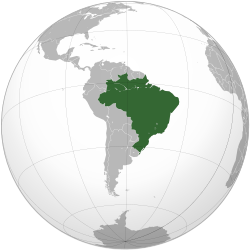Estado Novo (Brazil)
| Republic of the United States of Brazil (1889–1937) República dos Estados Unidos do Brasil United States of Brazil (1937–1967) Estados Unidos do Brasil |
||||||||||
|
||||||||||
|
||||||||||
|
Motto "Ordem e Progresso" "Order and Progress" |
||||||||||
|
Anthem Hino Nacional Brasileiro Brazilian National Anthem |
||||||||||
| Capital | Rio de Janeiro | |||||||||
| Languages | Portuguese | |||||||||
| Government | Federal single-party totalitarian dictatorship | |||||||||
| President | ||||||||||
| • | 1930–1945 | Getúlio Vargas | ||||||||
| • | 1945–1946 | José Linhares | ||||||||
| Provisional Military Junta | ||||||||||
| • | 1930 |
Augusto Tasso Fragoso Isaías de Noronha Mena Barreto |
||||||||
| Legislature | National Parliament | |||||||||
| • | Upper house | Federal Council | ||||||||
| • | Lower house | Chamber of Deputies | ||||||||
| Historical era | Interbellum · World War II | |||||||||
| • | Revolution of 1930 | 3 November 1930 | ||||||||
| • | Adoption of new Constitution | 16 July 1934 | ||||||||
| • | Communist Uprising | 23 November 1935 | ||||||||
| • | Estado Novo (dictatorship) | 10 November 1937 | ||||||||
| • | Brazil's entering WWII | 22 August 1942 | ||||||||
| • | Vargas Deposition | 29 October 1945 | ||||||||
| Area | ||||||||||
| • | 1903 | 8,515,767 km² (3,287,956 sq mi) | ||||||||
| Population | ||||||||||
| • | 1940 est. | 41 236 315 | ||||||||
| Currency |
Brazilian real (1930-1942) Cruzeiro (1942-1946) |
|||||||||
|
||||||||||
The Vargas Era (Portuguese: Era Vargas; Brazilian Portuguese: ['ɛɾɐ 'vaɾgɐs]) is the period in the history of Brazil between 1930 and 1945, when the country was under the dictatorship of Getúlio Dornelles Vargas.
The Brazilian Revolution of 1930 marked the end of the Old Republic. President Washington Luís was deposed; the swearing-in of President-elect Julio Prestes was blocked, on the grounds that the election had been rigged by his supporters; 1891 Constitution was abrogated, National Congress was dissolved and the provisional military junta ceded power to Vargas. Federal intervention in State governments increased and the political landscape was altered by suppressing the traditional oligarchies of São Paulo and Minas Gerais states.
The Vargas Era comprises three successive phases:
The deposition of Getúlio Vargas and his Estado Novo regime in 1945 and the subsequent re-democratization of Brazil with the adoption of a new Constitution in 1946 mark the end of the Vargas Era and the beginning of the period known as the Second Brazilian Republic.
The tenente rebellion did not mark the revolutionary breakthrough for Brazil's bourgeois social reformers, but the ruling paulista coffee oligarchy could not withstand the economic meltdown of 1929.
Brazil's vulnerability to the Great Depression had its roots in the economy's heavy dependence on foreign markets and loans. Despite limited industrial development in São Paulo, the export of coffee and other agricultural products was still the mainstay of the economy.
...
Wikipedia



